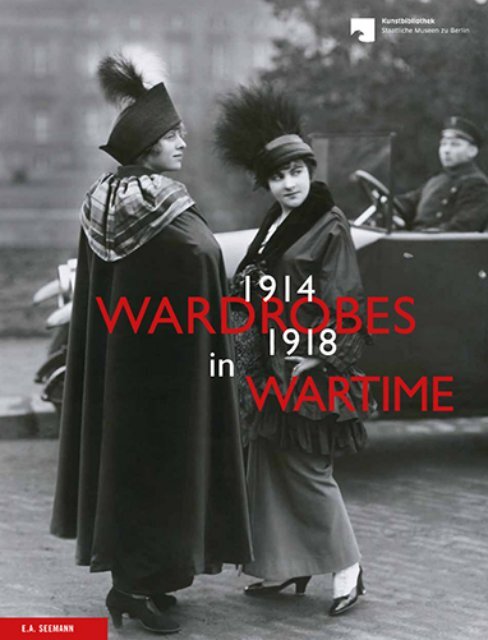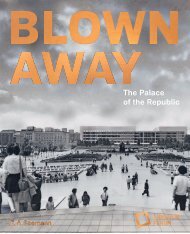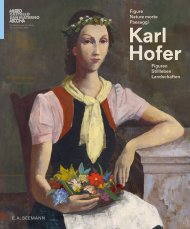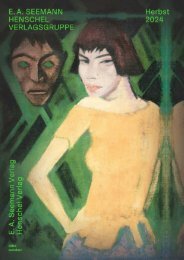Sample: Wardrobes in Wartime 1914-1918, Fashion and Fashion - Images during the First World War
The noteworthy years of the First World War, a now oft-forgotten period of turmoil in the history of fashion coming between Art Nouveau and the Twenties, proves to have been a time of amazing vitality and modernity. The attractive war crinoline with calf-length skirts, black as a fashion colour and comfortable suits of silk jersey are only a few of the stylistic innovations presented in this book featuring numerous never-before published original images. The political upheaval also impacted the increasing importance of fashion as a national economic factor. The artist Otto Haase-Heye’s luxurious Alfred-Marie fashion house established itself in Berlin and the “Association of the Fashion Industry” organised its much-noticed fashion weeks there. In Vienna, the avant-garde style of the Wiener Werkstätte and its graphic artists became firmly ingrained. And Paris, until then the undisputed capital of the fashion world, presented its newest collections in elegant journals such as Le Style Parisien and in atmospheric fashion photographs. The publication containing essays by Birgit Haase, Adelheid Rasche and Raffaella Sgubin features circa 240 artistic fashion prints, photographs, magazine covers and shows a selection of original European and North American clothes.
The noteworthy years of the First World War, a now oft-forgotten period of turmoil in the history of fashion coming between Art Nouveau and the Twenties, proves to have been a time of amazing vitality and modernity. The attractive war crinoline with calf-length skirts, black as a fashion colour and comfortable suits of silk jersey are only a few of the stylistic innovations presented in this book featuring numerous never-before published original images. The political upheaval also impacted the increasing importance of fashion as a national economic factor. The artist Otto Haase-Heye’s luxurious Alfred-Marie fashion house established itself in Berlin and the “Association of the Fashion Industry” organised its much-noticed fashion weeks there. In Vienna, the avant-garde style of the Wiener Werkstätte and its graphic artists became firmly ingrained. And Paris, until then the undisputed capital of the fashion world, presented its newest collections in elegant journals such as Le Style Parisien and in atmospheric fashion photographs. The publication containing essays by Birgit Haase, Adelheid Rasche and Raffaella Sgubin features circa 240 artistic fashion prints, photographs, magazine covers and shows a selection of original European and North American clothes.
You also want an ePaper? Increase the reach of your titles
YUMPU automatically turns print PDFs into web optimized ePapers that Google loves.
<strong><strong>War</strong>drobes</strong> <strong>in</strong> <strong><strong>War</strong>time</strong><br />
<strong>1914</strong> – <strong>1918</strong>
<strong><strong>War</strong>drobes</strong> <strong>in</strong> <strong><strong>War</strong>time</strong><br />
<strong>Fashion</strong> <strong>and</strong> <strong>Fashion</strong> <strong>Images</strong> dur<strong>in</strong>g <strong>the</strong> <strong>First</strong> <strong>World</strong> <strong>War</strong><br />
<strong>1914</strong> – <strong>1918</strong><br />
For <strong>the</strong> Kunstbiblio<strong>the</strong>k, Staatliche Museen zu Berl<strong>in</strong>,<br />
edited by Adelheid Rasche<br />
With a foreword by Moritz Wullen<br />
<strong>and</strong> contributions by Birgit Haase,<br />
Adelheid Rasche<br />
<strong>and</strong> Raffaella Sgub<strong>in</strong><br />
E. A. Seemann
Content<br />
7 Foreword<br />
Moritz Wullen<br />
8 Introduction<br />
Adelheid Rasche<br />
18 Modern Ambivalence:<br />
Women’s <strong>Fashion</strong>s dur<strong>in</strong>g <strong>the</strong> <strong>First</strong> <strong>World</strong> <strong>War</strong> from <strong>the</strong> German Perspective<br />
Birgit Haase<br />
38 Women <strong>and</strong> Work dur<strong>in</strong>g <strong>the</strong> <strong>First</strong> <strong>World</strong> <strong>War</strong>:<br />
Aspects of Cloth<strong>in</strong>g<br />
Raffaella Sgub<strong>in</strong><br />
ILLUSTRATIONS<br />
48 <strong>Fashion</strong> as a National Challenge<br />
60 New <strong>Fashion</strong> Trends dur<strong>in</strong>g <strong>the</strong> <strong>First</strong> <strong>World</strong> <strong>War</strong><br />
96 Viennese <strong>Fashion</strong> Pr<strong>in</strong>ts<br />
118 The Berl<strong>in</strong> Alfred-Marie <strong>Fashion</strong> House:<br />
Otto Haas-Heye <strong>and</strong> Annie Offterd<strong>in</strong>ger<br />
138 The Berl<strong>in</strong> <strong>Fashion</strong> Magaz<strong>in</strong>e Der Kleiderkasten<br />
148 The Gazette du Bon Ton<br />
154 Le Style Parisien<br />
160 La Mode par Fried<br />
170 The Parisian Modes et Manières d’Aujourd’hui Album<br />
184 Magaz<strong>in</strong>e Front Covers<br />
204 <strong>Fashion</strong> Photography from Paris, Berl<strong>in</strong> <strong>and</strong> Vienna<br />
222 References<br />
224 Illustration Credits
ForeWord<br />
Moritz Wullen<br />
<strong>Fashion</strong> tenaciously rushes on ahead of us <strong>in</strong> search for <strong>the</strong> new <strong>and</strong> <strong>in</strong>novative. The speed of<br />
this cultural system is possibly record-break<strong>in</strong>g. Even while we are still discover<strong>in</strong>g what is<br />
“current” <strong>in</strong> fashion, it has long set off for <strong>the</strong> future <strong>and</strong> stak<strong>in</strong>g its claims <strong>the</strong>re. <strong>Fashion</strong><br />
research is also <strong>in</strong> search of <strong>the</strong> new, but unlike fashion, it travels back along <strong>the</strong> timel<strong>in</strong>e <strong>in</strong>to<br />
<strong>the</strong> past. It is – like every academic discipl<strong>in</strong>e – driven by <strong>the</strong> spirit of discovery, <strong>the</strong> wish to<br />
f<strong>in</strong>d <strong>and</strong> stake out unknown territories.<br />
The 1910s is one example of such an uncharted territory that has previously been off our<br />
radar screen. The decades have, at <strong>the</strong> same time, represented <strong>the</strong> great successful br<strong>and</strong>s of<br />
<strong>the</strong> 20th century: <strong>the</strong> Golden Twenties, <strong>the</strong> Sw<strong>in</strong>g Era of <strong>the</strong> ’30s <strong>and</strong> ’40s, <strong>the</strong> petticoats, teddy<br />
boys <strong>and</strong> greasers of <strong>the</strong> ’50s, <strong>the</strong> forever young ’60s, <strong>the</strong> baroque ’70s, <strong>the</strong> – no adjective is<br />
necessary here – ’80s <strong>and</strong> <strong>the</strong> “grungy” ’90s. And let us not forget <strong>the</strong> 1900s. Under <strong>the</strong> nom de<br />
plume “Art Nouveau” <strong>the</strong>se years have also advanced to become a cult decade.<br />
But <strong>the</strong> 1910s is different. The decade bestowed <strong>the</strong> history of art with an unend<strong>in</strong>g series<br />
of surprises – blue horses, supremacist squares, Dadaist collages. At first glance, however, it<br />
seems to have contributed little to <strong>the</strong> history of fashion. Did everyone wear a uniform at that<br />
time or – catchword “nudism” – just <strong>the</strong>ir birthday suit? Along with <strong>the</strong> claustrophobic nightmare<br />
scenarios of stiff formal collars, aptly known <strong>in</strong> German as “Vätermörder” [literally<br />
“fa<strong>the</strong>r murderers”] <strong>and</strong> corsets, such prejudices still distort our view of that decade’s fashion<br />
today.<br />
The time is ripe to rediscover this period! The Lipperheide Costume Library – <strong>Fashion</strong><br />
Image Collection <strong>in</strong> <strong>the</strong> Kunstbiblio<strong>the</strong>k, one of <strong>the</strong> world’s largest fashion archives, features<br />
an overabundance of picture <strong>and</strong> text sources. Adelheid Rasche, <strong>the</strong> curator of <strong>the</strong> collection, is<br />
a scholar who knows how to br<strong>in</strong>g <strong>the</strong> cult decades of <strong>the</strong> 20th century to life like few o<strong>the</strong>rs.<br />
Based on <strong>the</strong>se archival treasures, Adelheid Rasche unfolds <strong>the</strong> pictorial world of a decade<br />
of fashion <strong>in</strong> <strong>the</strong> “<strong><strong>War</strong>drobes</strong> <strong>in</strong> <strong><strong>War</strong>time</strong>” exhibition that we have never seen before <strong>in</strong> this<br />
way. It is her contribution to <strong>the</strong> commemorations mark<strong>in</strong>g <strong>the</strong> centennial of <strong>the</strong> <strong>First</strong> <strong>World</strong><br />
<strong>War</strong>, which <strong>the</strong> Art Library is participat<strong>in</strong>g <strong>in</strong> with various exhibitions <strong>and</strong> publications. The<br />
present book is <strong>in</strong> itself an exhibition experience. I wish to enthusiastically express my gratitude<br />
on behalf of all <strong>the</strong> readers.<br />
Fig. p. 2: Book jacket (detail), Draw<strong>in</strong>g by George Barbier, 11,9 x 18,2 cm, from: La Guirl<strong>and</strong>e des Mois, 1919<br />
Fig. p. 4: Summer dress by Wiener Werkstätte, Photograph by unknown artist, 21,6 x 15,5 cm, 1916<br />
Fig. left: Silk cover, Draw<strong>in</strong>g by George Barbier, 12 x 8,2 cm, from: La Guirl<strong>and</strong>e des Mois, 1919
<strong>in</strong>troduCtion<br />
Adelheid Rasche<br />
Fig. 1: “Abschied <strong>1914</strong>, Wiedersehen 1916”, Draw<strong>in</strong>gs by<br />
Thomas Theodor He<strong>in</strong>e, 14 x 14 cm, from: Simplicissimus, 1916<br />
The political, economic <strong>and</strong> social upheaval that shook<br />
<strong>the</strong> very foundations of Europe <strong>and</strong> <strong>the</strong> world as a whole<br />
between <strong>1914</strong> <strong>and</strong> <strong>1918</strong>, br<strong>in</strong>g<strong>in</strong>g about irretrievable<br />
changes, also affected <strong>the</strong> silhouette of women’s cloth<strong>in</strong>g<br />
as well as <strong>the</strong> <strong>in</strong>creas<strong>in</strong>g significance of fashion as means<br />
of <strong>in</strong>dividual expression <strong>and</strong> symbolic form. Upon closer<br />
exam<strong>in</strong>ation, <strong>the</strong> supposed gap that ensued dur<strong>in</strong>g <strong>the</strong><br />
1910s <strong>and</strong> especially dur<strong>in</strong>g <strong>the</strong> noteworthy years of <strong>the</strong><br />
<strong>First</strong> <strong>World</strong> <strong>War</strong> proves to have been a time of amaz<strong>in</strong>g<br />
vitality <strong>and</strong> modernity. If one <strong>in</strong>itially believed that <strong>the</strong><br />
supply <strong>and</strong> consumption of fashion was tenuous dur<strong>in</strong>g<br />
<strong>the</strong> war years because of low dem<strong>and</strong>, decreased purchas<strong>in</strong>g<br />
power <strong>and</strong> <strong>the</strong> scarcity of available raw materials,<br />
a more detailed analysis quickly demonstrates <strong>the</strong> decisive<br />
role played by fashion at that time, especially <strong>in</strong> <strong>the</strong><br />
big cities. In her sem<strong>in</strong>al 2004 study on this subject, Enrica<br />
Mor<strong>in</strong>i names <strong>the</strong> various cultural factors that collectively<br />
contributed to <strong>the</strong> massive modernisation of women’s<br />
fashion <strong>in</strong> <strong>the</strong> first quarter of <strong>the</strong> 20th century: <strong>the</strong> grow<strong>in</strong>g<br />
<strong>in</strong>fluence of <strong>the</strong> young; <strong>the</strong> dress reform movement<br />
<strong>in</strong>itiated by artists; <strong>the</strong> <strong>in</strong>creas<strong>in</strong>g importance of sports<br />
<strong>and</strong> mobility for women <strong>in</strong> addition to <strong>the</strong> adoption of<br />
elements from men’s cloth<strong>in</strong>g 1 . Many cloth<strong>in</strong>g details<br />
<strong>in</strong>troduced as practical <strong>in</strong>novations dur<strong>in</strong>g <strong>the</strong> <strong>First</strong><br />
<strong>World</strong> <strong>War</strong> were reta<strong>in</strong>ed after <strong>the</strong> war <strong>and</strong> <strong>the</strong>y developed<br />
fur<strong>the</strong>r <strong>in</strong> terms of fashion. They <strong>in</strong>clude <strong>the</strong> heml<strong>in</strong>es<br />
that were considerably shortened for <strong>the</strong> first time <strong>in</strong><br />
<strong>the</strong> history of fashion, <strong>the</strong> smaller hats, <strong>the</strong> first short haircuts<br />
for women, washable cloth<strong>in</strong>g, materials like silk <strong>and</strong><br />
wool jersey, <strong>the</strong> preference for black as a fashion colour <strong>in</strong><br />
addition to simple <strong>and</strong> sporty day wear.
NEW FASHION TRENDS<br />
DURING THE FIRST WORLD WAR<br />
“It was to be expected that <strong>the</strong> uniform that is now at <strong>the</strong> centre of general <strong>in</strong>terest would also exert its<br />
<strong>in</strong>fluence on women’s fashion. And consequently field grey women’s fabrics have emerged as <strong>the</strong> first<br />
fashion <strong>in</strong>novation for women’s cloth<strong>in</strong>g to be developed <strong>in</strong> <strong>the</strong> style of our soldier’s uniform for fall <strong>and</strong><br />
w<strong>in</strong>ter suits.” 1<br />
This observation, which was published <strong>in</strong> mid November <strong>1914</strong> <strong>in</strong> <strong>the</strong> widely-read Berl<strong>in</strong><br />
journal Die Dame, makes obvious <strong>the</strong> drastic change <strong>in</strong> <strong>the</strong> colours used by fashion houses for<br />
<strong>the</strong>ir wartime collections. The greenish grey colour <strong>in</strong>troduced for German military uniforms<br />
under <strong>the</strong> name field grey <strong>in</strong> 1907 had a decisive impact on <strong>the</strong> new fashion dur<strong>in</strong>g <strong>the</strong> first<br />
w<strong>in</strong>ter of <strong>the</strong> war as well as <strong>the</strong> patriotic texts by fashion journalists. Ola Olsen, fashion editor<br />
of Elegante Welt, saw here “a lively confirmation, a powerful <strong>and</strong> strongly felt declaration of<br />
affiliation” 2 <strong>and</strong> repeatedly emphasised this colour’s symbolic force: “The field grey colour of<br />
our cloth<strong>in</strong>g speaks an energetic language; it is forceful <strong>and</strong> yet tranquil because it catches<br />
sight of our native country’s vast <strong>and</strong> expansive fields.” 3<br />
Restra<strong>in</strong>ed <strong>and</strong> shaded colours would dom<strong>in</strong>ate throughout <strong>the</strong> war years because “everyth<strong>in</strong>g<br />
loud <strong>and</strong> gaudy today would be like a jarr<strong>in</strong>g note, disrupt<strong>in</strong>g <strong>the</strong> subdued mood that<br />
is all around us.” 4 Along with field grey, an irritat<strong>in</strong>g colour from today’s perspective called<br />
“Bombenbraun” [literally bomb brown] 5 became widespread after <strong>the</strong> first w<strong>in</strong>ter of war, <strong>and</strong><br />
start<strong>in</strong>g <strong>in</strong> <strong>the</strong> fall of 1915 black was propagated as a fashionable colour: “Black will undoubtedly<br />
beat all <strong>the</strong> records this w<strong>in</strong>ter. Larger circles have f<strong>in</strong>ally recognised <strong>the</strong> consummate<br />
effect of noble black fabric. Black tulle, black chiffon, flow<strong>in</strong>g black silk materials <strong>and</strong> especially<br />
black velvet. … The black dress offers <strong>the</strong> broadest possibilities of unfold<strong>in</strong>g <strong>the</strong> elegan ce<br />
that is striven for at <strong>the</strong> moment.” 6 It can thus be demonstrated that black, previously seen as<br />
<strong>the</strong> colour of mourn<strong>in</strong>g <strong>in</strong> <strong>the</strong> bourgeois codex of <strong>the</strong> West, was already be<strong>in</strong>g worn <strong>in</strong><br />
Germa ny as a fashionable colour dur<strong>in</strong>g <strong>the</strong> <strong>First</strong> <strong>World</strong> <strong>War</strong>. The fashion houses placed<br />
along it “lush brown, <strong>the</strong> perennially popular navy blue, purple here <strong>and</strong> <strong>the</strong>re, <strong>and</strong> some<br />
<strong>in</strong>dividual white dresses for young women.” 7 The available patterns mostly <strong>in</strong>cluded stripes<br />
as well as detailed floral designs, largescale or multicoloured patterns were, by contrast,<br />
hardly be<strong>in</strong>g produced at <strong>the</strong> time for reasons of cost.<br />
All <strong>the</strong> belligerent nations had to drastically restrict <strong>the</strong> production of textiles to fulfil <strong>the</strong><br />
cloth<strong>in</strong>g needs of <strong>the</strong> civilian population over <strong>the</strong> course of <strong>the</strong> war <strong>and</strong> also had to deal<br />
with <strong>the</strong> problem of severe shortages of raw materials. 8 Wool fabrics, for example, were<br />
rationed for <strong>the</strong> general populace start<strong>in</strong>g <strong>in</strong> February 1916 because <strong>the</strong>y were required by<br />
<strong>the</strong> military. The result was an enormous <strong>in</strong>crease <strong>in</strong> <strong>the</strong> production of velveteen, which<br />
was used for coats with fur l<strong>in</strong><strong>in</strong>g <strong>and</strong> for tea gowns. A new solution had to be found when
“Fräule<strong>in</strong> Feldgrau”, Field postcard, 8,6 x 13,4 cm, 1916<br />
New <strong>Fashion</strong> Trends dur<strong>in</strong>g <strong>the</strong> <strong>First</strong> <strong>World</strong> <strong>War</strong> 61
62<br />
New <strong>Fashion</strong> Trends dur<strong>in</strong>g <strong>the</strong> <strong>First</strong> <strong>World</strong> <strong>War</strong><br />
Germany’s reserves of raw cotton were exhausted.<br />
“The war itself favours <strong>the</strong> use of luxury fabrics” 9<br />
wrote Norbert Stern <strong>in</strong> <strong>the</strong> fall of 1916 because only<br />
limited amounts of all materials were available<br />
with ration coupons or not at all. The fashion<br />
<strong>in</strong>dustry now used large amounts of silk fabrics <strong>in</strong><br />
all qualities <strong>and</strong> weaves that were previously<br />
regarded as much too expensive. Particularly<br />
popular were <strong>the</strong> newly developed silk tricot, also<br />
known as silk jersey, which was made <strong>in</strong>to dresses,<br />
blouses <strong>and</strong> leisure suits. The textile <strong>in</strong>dustry fur<strong>the</strong>rmore<br />
manufactured its first textiles made from<br />
syn<strong>the</strong>tic fibres as well as cloth from paper weave,<br />
but it proved not to be durable <strong>and</strong>, as a <strong>1918</strong> Simplicissimus<br />
caricature conv<strong>in</strong>c<strong>in</strong>gly demonstrated,<br />
apparently only reservedly water-resistant.<br />
It was not only <strong>the</strong> omnipresent grey <strong>and</strong> o<strong>the</strong>r<br />
muted colours that created a close l<strong>in</strong>k between<br />
<strong>the</strong> fashionable silhouette <strong>and</strong> military uniforms<br />
but also <strong>the</strong> use of <strong>in</strong>dividual design elements:<br />
Small st<strong>and</strong>-up collars <strong>in</strong> <strong>the</strong> case of blouses <strong>and</strong><br />
suits, sewn-on pockets, helmet-like headwear,<br />
braided trimm<strong>in</strong>gs <strong>and</strong> colourfully piped seams,<br />
capes <strong>and</strong> severely tailored suit jackets are only a<br />
few of <strong>the</strong> most conspicuous details. The <strong>in</strong>fluence<br />
of <strong>the</strong> nurses’ uniform on <strong>the</strong> cuts of simple day<br />
dresses as well as <strong>the</strong> now oft-worn sensible comb<strong>in</strong>ation<br />
of blouse <strong>and</strong> skirt is fur<strong>the</strong>rmore unmistakable.<br />
“E<strong>in</strong> Familien-Ausflug”, Draw<strong>in</strong>g by Thomas Theodor He<strong>in</strong>e, 29,5 x 14 cm,<br />
from: Simplicissimus, <strong>1918</strong><br />
“Praktisch” [sensible or practical] was one of <strong>the</strong><br />
most used adjectives <strong>in</strong> <strong>the</strong> fashion press of <strong>the</strong> war<br />
years; its usage was consistently widespread <strong>and</strong><br />
was supplemented by “pla<strong>in</strong>” or “modest” <strong>in</strong> <strong>the</strong><br />
f<strong>in</strong>al year of war. “Practical” could have various<br />
mean<strong>in</strong>gs: Certa<strong>in</strong> articles of cloth<strong>in</strong>g such as suits,<br />
aprons, coat dresses <strong>and</strong> blouses were characterised<br />
as such; easily washable <strong>and</strong> dark materials<br />
were likewise considered practical. And f<strong>in</strong>ally <strong>the</strong><br />
new, now only calf-length skirts became st<strong>and</strong>ard<br />
with<strong>in</strong> a brief period of time thanks to <strong>the</strong> declaration<br />
that <strong>the</strong>y were suitable for daily use. The wide<br />
cr<strong>in</strong>ol<strong>in</strong>e skirts dat<strong>in</strong>g from 1915 were – despite <strong>the</strong><br />
argument of coquetry <strong>and</strong> that <strong>the</strong>y represented a<br />
waste of fabric – also deemed “practical” <strong>and</strong> rapidly<br />
established <strong>the</strong>mselves.<br />
The liv<strong>in</strong>g condition of most women underwent<br />
a radical change s<strong>in</strong>ce <strong>the</strong> outbreak of <strong>the</strong> war <strong>and</strong><br />
dem<strong>and</strong>ed a wardrobe that took this <strong>in</strong>to consideration.<br />
In everyday life, which was shaped by<br />
one’s own ga<strong>in</strong>ful employment or by tak<strong>in</strong>g care of<br />
err<strong>and</strong>s outdoors, a wellfitt<strong>in</strong>g tailored suit of a<br />
durable dark fabric that could be comb<strong>in</strong>ed with
New <strong>Fashion</strong> Trends dur<strong>in</strong>g <strong>the</strong> <strong>First</strong> <strong>World</strong> <strong>War</strong> 63<br />
“Interviews Kôlôssâles sur la ‘Kriegsbluse’”, Draw<strong>in</strong>gs by M. Radiguet, 24,2 x 31,8 cm, from: Mode <strong>in</strong> Germany, Paris 1915<br />
different blouses was required <strong>in</strong>stead of <strong>the</strong> previously common morn<strong>in</strong>g dress. Along with<br />
easy to wash colours – preferably <strong>in</strong> blue, brown, grey or black – a comfortable cut was of<br />
importance: “But now, when practically every woman without exception is compelled more<br />
than ever before to walk down busy streets, often weighed down with packages, it would be<br />
grotesque if she foolishly also decided to wear a dress that would h<strong>in</strong>der her stride.” 10 Alongside<br />
<strong>the</strong> suit, socalled coat dresses established <strong>the</strong>mselves after 1917. They represent a hybrid<br />
of high-necked dress <strong>and</strong> coat that made considerable sav<strong>in</strong>gs of both money <strong>and</strong> fabric possible<br />
because one item of cloth<strong>in</strong>g could be worn for two purposes. Apron dresses with<br />
sewed-on pockets that could be comb<strong>in</strong>ed with blouses were also popular. Because <strong>the</strong> dress<br />
did not have to be changed as often, <strong>the</strong>re were also sav<strong>in</strong>gs as regards wash<strong>in</strong>g, which played<br />
a significant role as soap <strong>and</strong> laundry detergent were likewise rationed.
64<br />
New <strong>Fashion</strong> Trends dur<strong>in</strong>g <strong>the</strong> <strong>First</strong> <strong>World</strong> <strong>War</strong><br />
The loosely fall<strong>in</strong>g blouse to supplement skirt <strong>and</strong> suit<br />
was described as someth<strong>in</strong>g special <strong>in</strong> <strong>the</strong> German fashion<br />
press after 1915; particularly <strong>the</strong> “Viennese blouse”<br />
enjoyed a great deal of popularity: “The so-called ‘simple’<br />
blouses that Vienna also supplies <strong>in</strong> large numbers might<br />
appear <strong>the</strong> most attractive to some tastes. Elegant simplicity<br />
is expressed <strong>in</strong> all <strong>the</strong> shirt blouses decorated with<br />
hemstitches, f<strong>in</strong>e embroideries <strong>and</strong> attractive buttons.” 11<br />
From <strong>the</strong> w<strong>in</strong>ter of 1916, strik<strong>in</strong>g caracos, which were<br />
worn over <strong>the</strong> skirt, convey<strong>in</strong>g a very eye-catch<strong>in</strong>g <strong>and</strong><br />
modern impression, came as an <strong>in</strong>novation onto <strong>the</strong> market:<br />
“It also falls freely <strong>and</strong> is sometimes only slightly<br />
girded; <strong>the</strong> body is never constra<strong>in</strong>ed, receiv<strong>in</strong>g that<br />
sway<strong>in</strong>g poise that we so appreciate <strong>in</strong> modern woman.” 12<br />
Although fashion magaz<strong>in</strong>es from various countries<br />
prove that <strong>the</strong> overly practical comb<strong>in</strong>ation of skirt <strong>and</strong><br />
blouse was commonly worn elsewhere as well, <strong>the</strong> blouse<br />
fashion, seen from a contemporary perspective, appears<br />
to be a typically German phenomenon. How else could<br />
we expla<strong>in</strong> <strong>the</strong> fact that <strong>the</strong> satirical album Mode <strong>in</strong><br />
Germa ny, which was probably published <strong>in</strong> 1915 <strong>in</strong> Paris,<br />
focuses on <strong>the</strong> German blouse <strong>in</strong> its Interviews Kôlôssâles<br />
sur la ‘Kriegsbluse’? In five draw<strong>in</strong>gs <strong>and</strong> accompany<strong>in</strong>g<br />
verses, <strong>the</strong> German emperor, <strong>the</strong> crown pr<strong>in</strong>ce, General<br />
Eulenburg <strong>and</strong> <strong>the</strong> Austrian emperor are questioned<br />
about <strong>the</strong> “Kriegsbluse” [war blouse], a caraco with light<br />
sleeves <strong>and</strong> collar. None of <strong>the</strong>m are capable of expla<strong>in</strong><strong>in</strong>g<br />
what is so special about it until <strong>the</strong> end when a French<br />
soldier (Pioupiou) reveals it to be a mere adaptation of a<br />
uniform jacket, “à deux couleurs, avec pattes, parements,<br />
et bouton de métal”. 13<br />
“Sur le Costume Tailleur”, Draw<strong>in</strong>g by Georges Lepape, 24,5 x 19 cm,<br />
Short <strong>and</strong> wide is <strong>the</strong> motto of modern dresses. Very from: Gazette du Bon Ton, <strong>1914</strong><br />
wide <strong>and</strong> very short. “If <strong>the</strong>y [<strong>the</strong> skirts] are to be considerably<br />
shortened any fur<strong>the</strong>r, <strong>the</strong>n it is probably not due<br />
to coquetry but solely as a result of practical considerations. … The waist rema<strong>in</strong>s narrow<br />
despite <strong>the</strong> wide skirt, which is why <strong>the</strong> petticoat cl<strong>in</strong>gs here without folds so that it can<br />
widen downwards <strong>in</strong> a bell or umbrella cut.” 14 This is how <strong>the</strong> Elegante Welt expla<strong>in</strong>ed <strong>the</strong><br />
wide skirt form <strong>in</strong> May 1915 that had become fashionable earlier <strong>in</strong> <strong>the</strong> year, <strong>the</strong> silhouette<br />
of which recalled <strong>the</strong> hoop skirts of <strong>the</strong> 18th or 19th centuries <strong>and</strong> promised a nostalgic look<br />
back at happier days. 15<br />
Although it seem<strong>in</strong>gly contradicts <strong>the</strong> daily hardships with <strong>the</strong> start of <strong>the</strong> ration<strong>in</strong>g of<br />
fabric accompany<strong>in</strong>g <strong>the</strong> war, <strong>the</strong>re were soon numerous arguments <strong>in</strong> its favour that resulted<br />
<strong>in</strong> this form of skirt becom<strong>in</strong>g widely accepted. On <strong>the</strong> one h<strong>and</strong>, one repeatedly read about<br />
<strong>the</strong> practical aspects of <strong>the</strong> wide skirt that was simultaneously shortened to calf-length, which<br />
offered women a never-before known freedom of movement that was greatly appreciated <strong>in</strong><br />
everyday life. On <strong>the</strong> o<strong>the</strong>r h<strong>and</strong>, it was also argued that <strong>the</strong> additional fabric required to<br />
make such wider skirts, which would later be called “war cr<strong>in</strong>ol<strong>in</strong>e”, meant supplemental<br />
earn<strong>in</strong>gs for a troubled textile <strong>in</strong>dustry <strong>and</strong> consequently a direct form of promot<strong>in</strong>g <strong>the</strong><br />
econo my. However, despite explanations targeted at expediency, symbolic as well as emotional<br />
factors also played an important role because it was precisely this very graceful silhouette<br />
that made it possible for women to set <strong>the</strong>mselves off aga<strong>in</strong>st <strong>the</strong> omnipresent image of <strong>the</strong><br />
uniformed man. As <strong>the</strong> Elegante Welt wrote <strong>in</strong> September 1915: “That women’s tastes have
New <strong>Fashion</strong> Trends dur<strong>in</strong>g <strong>the</strong> <strong>First</strong> <strong>World</strong> <strong>War</strong> 65<br />
“Sur le Costume Tailleur”, Draw<strong>in</strong>gs by Georges Lepape, 24,5 x 38 cm, from: Gazette du Bon Ton, <strong>1914</strong><br />
changed to such an extent, that charm <strong>and</strong> unconditional expediency merged is surely a good<br />
sign for <strong>the</strong> <strong>in</strong>ner value of <strong>the</strong> woman <strong>in</strong> this year of war.” 16<br />
The war was only a few weeks old when <strong>the</strong> fashion journals took up <strong>the</strong> topic of appropriate<br />
mourn<strong>in</strong>g cloth<strong>in</strong>g for <strong>the</strong> first time, a subject that would be controversially discussed<br />
on a regular basis. Margare<strong>the</strong> von Suttner wrote <strong>in</strong> Elegante Welt: “The suggestion<br />
has come … from various sides that those affected by a death <strong>in</strong> <strong>the</strong> family should now not<br />
express <strong>the</strong>ir mourn<strong>in</strong>g outwardly through <strong>the</strong>ir cloth<strong>in</strong>g. Personally, I can only share this<br />
op<strong>in</strong>ion at <strong>the</strong> very least with one reservation, <strong>and</strong> this consists of omitt<strong>in</strong>g <strong>the</strong> long crepe<br />
veil dur<strong>in</strong>g this exceptional period <strong>in</strong> <strong>the</strong> <strong>in</strong>terest of <strong>the</strong> public at large … Dark cloth<strong>in</strong>g,<br />
dark furs, dark hats, beautiful fabrics <strong>and</strong> a fashionable cut …, that is how elegance will be<br />
shown dur<strong>in</strong>g this memorable w<strong>in</strong>ter.” 17 More radical positions dem<strong>and</strong>ed a clear differentiation<br />
between private mourn<strong>in</strong>g <strong>and</strong> mourn<strong>in</strong>g for a soldier who was killed <strong>in</strong> action<br />
because “<strong>the</strong> soldier who fought for <strong>the</strong> general public has also fallen for <strong>the</strong> general public.” 18<br />
One should <strong>the</strong>refore forego official mourn<strong>in</strong>g clo<strong>the</strong>s <strong>in</strong> order to spare o<strong>the</strong>r women <strong>the</strong><br />
dishearten<strong>in</strong>g view <strong>and</strong> to save <strong>the</strong> cities from such sombre street scenes. Sav<strong>in</strong>gs as far as<br />
fabric <strong>and</strong> material are concerned were listed as fur<strong>the</strong>r reasons for do<strong>in</strong>g without especially<br />
purchased mourn<strong>in</strong>g clo<strong>the</strong>s.
REFERENCES<br />
[Historical articles from magaz<strong>in</strong>es are quoted <strong>in</strong> <strong>the</strong> notes <strong>and</strong> do not appear here]<br />
Alatri / Gagliardo 2013<br />
Alatri, Giovanna; Gagliardo, Francesca: Cappelli e Fornelli. Moda<br />
e ricette per le maestre d’<strong>in</strong>izio ’900. Rome 2013, pp. 52 f.<br />
Alligo / Ercoli 2011<br />
Alligo, Santo; Ercoli, Giuliano: Modes et manières d’aujourd’hui.<br />
Qu<strong>and</strong>o l’illustrazione di moda diventa gr<strong>and</strong>e arte. Tor<strong>in</strong>o 2011.<br />
Brachet-Champsaur 2004<br />
Brachet-Champsaur, Florence: De l’odalisque de Poiret à la femme<br />
nouvelle de Chanel: Une victoire de la femme? In: Évelyne Mor<strong>in</strong>-<br />
Rotureau: Combats de femmes <strong>1914</strong> –<strong>1918</strong>. Paris 2004, pp. 200 –226.<br />
Breward / Evans 2005<br />
Breward, Christopher; Evans, Carol<strong>in</strong>e (Ed.): <strong>Fashion</strong> <strong>and</strong> Modernity.<br />
Oxford etc. 2005.<br />
Bücherlust 1998<br />
Bücherlust: Buchkunst und Bücherluxus im 20. Jahrhundert, Beispiele<br />
aus e<strong>in</strong>er Stuttgarter Sammlung. Stuttgart 1998.<br />
Chaumette et al. 1992<br />
Chaumette, Xavier; Montet, Emmanuelle; Fauque, Claude: Le Tailleur.<br />
Un vêtement-message. Paris 1992.<br />
Daniel 2004<br />
Daniel, Ute: Frauen. In: Gerhard Hirschfeld; Gerd Krumreich;<br />
Ir<strong>in</strong>a Renz (Ed.): Enzyklopädie Erster Weltkrieg. 2 nd , revised ed.,<br />
Paderborn et al. 2004, pp. 116 –134.<br />
David 2009<br />
David, Alison Mat<strong>the</strong>ws: <strong>Fashion</strong>’s Chamelions. Camouflage,<br />
‘Conspicuousness’, <strong>and</strong> Gendered Display Dur<strong>in</strong>g <strong>World</strong> <strong>War</strong> I.<br />
In: John Potv<strong>in</strong> (Ed.): The Places <strong>and</strong> Spaces of <strong>Fashion</strong>, 1800 –2007.<br />
New York 2009, pp. 89–107.<br />
Davis 2006<br />
Davis, Mary: Classic Chic. Music, <strong>Fashion</strong> <strong>and</strong> Modernism. Berkeley<br />
2006.<br />
Demornex 2007<br />
Demornex, Jacquel<strong>in</strong>e: Lucien Lelong, l’<strong>in</strong>temporel. Paris 2007.<br />
Desl<strong>and</strong>res 1986<br />
Desl<strong>and</strong>res, Yvonne: Poiret. Paul Poiret, 1879–1944. Paris 1986.<br />
Desl<strong>and</strong>res / Müller 1986<br />
Desl<strong>and</strong>res, Yvonne; Müller, Florence: Histoire de la mode au XXe<br />
siècle. Paris 1986.<br />
Donne nella gr<strong>and</strong>e guerra 2012<br />
Donne nella gr<strong>and</strong>e guerra. Exh. cat. Musei Prov<strong>in</strong>ciali di Gorizia.<br />
Gorizia 2012.<br />
Field 2001<br />
Field, Jacquel<strong>in</strong>e: Dyes, Chemistry <strong>and</strong> Cloth<strong>in</strong>g: The Influence of<br />
<strong>World</strong> <strong>War</strong> I on Fabrics, <strong>Fashion</strong>s <strong>and</strong> Silk. In: Dress, Vol. 28 (2001),<br />
pp. 77– 91.<br />
Gaudriault 1983<br />
Gaudriault, Raymond: La gravure de mode fém<strong>in</strong><strong>in</strong>e en France.<br />
Paris 1983.<br />
Gundlach / Richter 1993<br />
Gundlach, Franz C.; Richter, Uli (Ed.): Berl<strong>in</strong> en Vogue: Berl<strong>in</strong>er<br />
Mode <strong>in</strong> der Photographie. Tüb<strong>in</strong>gen 1993.<br />
Haas-Heye 1916<br />
Haas-Heye, Otto (Ed.): Graphische Modeblätter. Berl<strong>in</strong> 1916.<br />
Haase 2008<br />
Haase, Birgit: “Metamorphose des Girl” – Tendenzen der Damenmode<br />
<strong>in</strong> der späten Weimarer Republik. In: Verena Dollenmaier;<br />
Ursel Berger (Ed.): Glamour! Das Girl wird fe<strong>in</strong>e Dame – Frauendarstellungen<br />
<strong>in</strong> der späten Weimarer Republik. Exh. cat. Georg<br />
Kolbe Museum Berl<strong>in</strong>. Leipzig 2008, pp. 28 – 44.<br />
Haase 2013<br />
Haase, Birgit: Mustergültig – Die Farbe Schwarz à la mode moderne.<br />
In: Katr<strong>in</strong> L<strong>in</strong>demann; Iris Kolhoff-Kahl (Ed.): Muster <strong>in</strong> Mode-<br />
Textil-Design. Festschrift for Prof. Dr. Jutta Beder. Berl<strong>in</strong> 2013,<br />
pp. 82 – 92.<br />
Hall-Duncan 1979<br />
Hall-Duncan, Nancy: The history of fashion photography. New<br />
York 1979.<br />
Hansen 1984<br />
Hansen, Traude: Wiener Werkstätte – Mode, Stoffe, Schmuck,<br />
Accessoires. Vienna 1984.<br />
Haye 2011<br />
Haye, Amy de la: Chanel. Couture <strong>and</strong> Industry. London 2011.<br />
Hirschfeld 1929<br />
Hirschfeld, Magnus; Gaspar, Andreas (Ed.): Sittengeschichte des<br />
Ersten Weltkrieges. Repr<strong>in</strong>t of <strong>the</strong> 2 nd ., revised ed. [Frechen c. 1981].<br />
(1st ed. 1929)<br />
Hirschfeld et al. 2004<br />
Hirschfeld, Gerhard; Krumreich, Gerd; Renz, Ir<strong>in</strong>a (Ed.): Enzyklopädie<br />
Erster Weltkrieg. 2 nd , revised ed. Paderborn et al. 2004.<br />
Horbas 1994<br />
Horbas, Claudia: Frühe Modefotografie Pariser Ateliers. Berl<strong>in</strong><br />
1994.
References 223<br />
Jenß 2001<br />
Jenß, Heike: Retro-Looks <strong>in</strong> Modedesign und Jugendkultur –<br />
Tom Ford (Gucci), Anna Sui und die Mods. In: Gabriele Mentges;<br />
Heide Nixdorff: Textil – Körper – Mode. Dortmunder Reihe zu<br />
kulturanthropologischen Studien, no. 1: zeit.schnitte. Berl<strong>in</strong> 2001,<br />
pp. 225 – 301.<br />
Kaufhold 1993<br />
Enno Kaufhold: Fixierte Eleganz. Photographien der Berl<strong>in</strong>er<br />
Mode. In: F.C. Gundlach; Uli Richter (Ed.): Berl<strong>in</strong> en Vogue: Berl<strong>in</strong>er<br />
Mode <strong>in</strong> der Photographie. Tüb<strong>in</strong>gen 1993, pp. 13 – 46.<br />
Kleider machen Politik 2002<br />
Kleider machen Politik. Zur Repräsentation von Nationalstaat und<br />
Politik durch Kleidung <strong>in</strong> Europa vom 18. bis 20. Jahrhundert. Cat.<br />
L<strong>and</strong>esmuseum Oldenburg, Vol. 19. Oldenburg 2002.<br />
Koda / Bolton 2007<br />
Koda, Harold; Bolton, Andrew: Poiret. Exh. cat. The Metropolitan<br />
Museum of Art. New York et al. 2007.<br />
Les arts français <strong>1918</strong><br />
Les arts français, no. 19 (<strong>1918</strong>). Special edition: Le costume et la<br />
mode de <strong>1914</strong> à <strong>1918</strong>.<br />
Mackrell 1992<br />
Mackrell, Alice: Coco Chanel. London 1992.<br />
Mart<strong>in</strong> / Koda 1989<br />
Mart<strong>in</strong>, Richard; Koda, Harold: The Historical Mode. <strong>Fashion</strong> <strong>and</strong><br />
Art <strong>in</strong> <strong>the</strong> 1980s. Exh. cat. <strong>Fashion</strong> Institute of Technology. New<br />
York 1989.<br />
Metropolen machen Mode 1989<br />
Metropolen machen Mode. Haute Couture der Zwanziger Jahre.<br />
Cat. Kunstgewerbemuseum Berl<strong>in</strong>, Staatliche Museen Preußischer<br />
Kulturbesitz, 3 rd , revised ed. Berl<strong>in</strong> 1989.<br />
Mor<strong>in</strong>-Rot<strong>in</strong>eau 2004<br />
Mor<strong>in</strong>-Rot<strong>in</strong>eau, Evelyne (Ed.): <strong>1914</strong> –<strong>1918</strong>: Combats de femmes.<br />
Les femmes, pilier de l‘effort de guerre. Paris 2004.<br />
Mor<strong>in</strong>i / Ros<strong>in</strong>a 2003<br />
Mor<strong>in</strong>i, Enrica; Ros<strong>in</strong>a, Margherita (Ed.): Le donne, la moda, la<br />
guerra. Emancipazione femm<strong>in</strong>ile e moda durante la Prima guerra<br />
mondiale. Exh. cat. Museo Storico Italiano della Guerra Rovereto.<br />
Rovereto 2003.<br />
Radiguet / Arnac [1915]<br />
Radiguet, Maurice; Arnac, Marcel: Mode <strong>in</strong> Germany. Paris [1915].<br />
Rasche 1995<br />
Rasche, Adelheid: Peter Jessen, der Berl<strong>in</strong>er Vere<strong>in</strong> Moden-<br />
Museum und der Verb<strong>and</strong> der deutschen Mode-Industrie, 1916 bis<br />
1925. In: Waffen- und Kostümkunde. Zeitschrift der Gesellschaft<br />
für Historische Waffen- und Kostümkunde, Vol. 37, no. 1 <strong>and</strong> 2<br />
(1995), pp. 65 – 92.<br />
Rasche 1998<br />
Rasche, Adelheid: Wiener Mode <strong>in</strong> Berl<strong>in</strong>, 1907 bis 1932. In: Intermezzo<br />
Berl<strong>in</strong>. Wiener <strong>in</strong> Berl<strong>in</strong> 1890 –1933. Cat. Kunstbiblio<strong>the</strong>k<br />
Berl<strong>in</strong>, Berl<strong>in</strong> 1998, pp. 29– 36.<br />
Rothste<strong>in</strong> 1992<br />
Rothste<strong>in</strong>, Natalie (Ed.): Four Hundred Years of <strong>Fashion</strong>. Cat.<br />
Victoria <strong>and</strong> Albert Museum London, 2. ed. London 1992.<br />
Rücker 1984<br />
Rücker, Elisabeth: Wiener Charme. Mode <strong>1914</strong>/15, Graphiken und<br />
Accessoires. Exh. cat. Germanisches Nationalmuseum. Nuremberg<br />
1984.<br />
Runde 1986<br />
Runde, Sab<strong>in</strong>e: Welt ohne Alltag: Modegraphik der 20er Jahre von<br />
Annie Offterd<strong>in</strong>ger. Frankfurt 1986.<br />
S<strong>and</strong>er 1915<br />
S<strong>and</strong>er, Klara: Die Mode im Spiegel des Krieges. Essen 1915.<br />
Stahl 1915<br />
Stahl, Fritz (i. e. Siegfried Lilienthal): Deutsche Form. Die Eigenwerdung<br />
der deutschen Mode<strong>in</strong>dustrie, e<strong>in</strong>e nationale und wirtschaftliche<br />
Notwendigkeit. (Flugschrift des Deutschen Werkbundes)<br />
Berl<strong>in</strong> 1915.<br />
Stern 1915a<br />
Stern, Norbert: Die Weltpolitik der Weltmode. In: Der Deutsche<br />
Krieg. Politische Flugschriften. Ed. by Ernst Jäckh. No. 30/341<br />
(1915), pp. 7– 59.<br />
Stern 1915b/c<br />
Stern, Norbert: Mode und Kultur. 2 Vol., Dresden 1915 (Vol. 1:<br />
Psychologisch-äs<strong>the</strong>tischer Teil; Vol. 2: Wirtschaftlich-politischer<br />
Teil).<br />
The 1915 Mode as shown by Paris. [1915]<br />
The 1915 Mode as shown by Paris. Panama Pacific International<br />
Exposition. New York [1915].<br />
Troy 2002<br />
Troy, Nancy: Paul Poiret’s M<strong>in</strong>aret Style: Orig<strong>in</strong>ality, Reproduction<br />
<strong>and</strong> Art <strong>in</strong> <strong>Fashion</strong>. In: <strong>Fashion</strong> Theory. The Journal of Dress,<br />
Body <strong>and</strong> Culture. Vol. 6, no. 2 (June 2002), pp. 117–144.<br />
Völker 1984<br />
Völker, Angela: Wiener Mode + Modefotografie. Die Modeabteilung<br />
der Wiener Werkstätte 1911–1932. Cat. Österreichisches<br />
Museum für angew<strong>and</strong>te Kunst, Munich 1984.<br />
Wagner 1999<br />
Wagner, Gretel: Otto Haas-Heye. Die Zeit <strong>in</strong> Berl<strong>in</strong> <strong>1914</strong> –1925.<br />
In: Waffen- und Kostümkunde. Zeitschrift der Gesellschaft für<br />
Historische Waffen- und Kostümkunde, Vol. 41, no. 1 (1999),<br />
pp. 41– 66.<br />
Wilson 2005<br />
Wilson, Elizabeth: <strong>Fashion</strong> <strong>and</strong> Modernity. In: Christopher Breward;<br />
Carol<strong>in</strong>e Evans (Ed.): <strong>Fashion</strong> <strong>and</strong> Modernity. Oxford 2005,<br />
pp. 9 –14.<br />
Zika 2006<br />
Zika, Anna: Ist alles eitel? Zur Kulturgeschichte deutschsprachiger<br />
Modejournale zwischen Aufklärung und Zerstreuung, 1750 –1950.<br />
Weimar 2006.<br />
Raydt 1917<br />
Raydt, Elsa: Deutsche Modebestrebungen. (Das Reich der Frau<br />
XXXIX) In: Westermanns Monatshefte. Illustr. Zeitschrift fürs<br />
deutsche Haus, Vol. 61, no. 9 (May 1917), pp. 356 – 362.
ILLUSTRATION CREDITS / IMPRINT<br />
Illustration Credits<br />
<strong>Images</strong> <strong>and</strong> copyright clearance have been k<strong>in</strong>dly supplied as listed below. Unless o<strong>the</strong>rwise stated below or <strong>in</strong> <strong>the</strong> captions, images are<br />
© Staatliche Museen zu Berl<strong>in</strong>, Kunstbiblio<strong>the</strong>k<br />
p. 22: © Germanisches Nationalmuseum, Nürnberg; pp. 24, 36: © 2014 Museum Associates/LACMA Los Angeles County Museum of Art;<br />
pp. 24, 94: © Universitätsbiblio<strong>the</strong>k Heidelberg; p. 30: © Victoria <strong>and</strong> Albert Museum, London; pp. 30, 32, 33: Museum für Kunst und<br />
Gewerbe Hamburg; p. 31: Museum für Hamburgische Geschichte, Hamburg Museum; pp. 31, 35: © The Museum at FIT, <strong>Fashion</strong> Institute<br />
of Technology New York; pp. 32, 37: Les Arts décoratifs – Musée de la Mode et du Textile, Paris; pp. 34, 37, 38: © The Metropolitan Museum<br />
of Art, New York. Image source: Art Resource, NY; p. 36: © Musei Prov<strong>in</strong>ciali di Gorizia, Museo della Moda e delle Arti Applicate; p. 67:<br />
© Staatliche Museen zu Berl<strong>in</strong>, Museum Europäischer Kulturen, photo: Ute Franz-Scarciglia<br />
Every effort has been made to trace <strong>and</strong> contact copyright holders. If <strong>the</strong>re are any <strong>in</strong>advertent omissions we apologise to those concerned,<br />
<strong>and</strong> ask that you contact us so that we can correct any oversight as soon as possible.<br />
Impr<strong>in</strong>t<br />
This volume is published <strong>in</strong> conjunction with <strong>the</strong> exhibition:<br />
<strong><strong>War</strong>drobes</strong> <strong>in</strong> <strong><strong>War</strong>time</strong> – <strong>Fashion</strong> <strong>Images</strong> dur<strong>in</strong>g <strong>the</strong> <strong>First</strong> <strong>World</strong> <strong>War</strong><br />
Kunstbiblio<strong>the</strong>k, Staatliche Museen zu Berl<strong>in</strong><br />
Kulturforum Potsdamer Platz<br />
25 th September 2014 to 18 th January 2015<br />
www.smb.museum<br />
Project management, book editor <strong>and</strong> exhibition curator: Adelheid Rasche<br />
Texts: Birgit Haase, Adelheid Rasche, Raffaella Sgub<strong>in</strong>, Moritz Wullen<br />
Text Edit<strong>in</strong>g: Adelheid Rasche<br />
Reproduction photographs: Anna Russ<br />
Picture Edit<strong>in</strong>g: Daniela Kratz-Grönwald<br />
Translation: Michael Wolfson<br />
Copy-edit<strong>in</strong>g: Aaron Shoichet<br />
Publish<strong>in</strong>g coord<strong>in</strong>ation: Carol<strong>in</strong>e Keller<br />
Graphic design <strong>and</strong> cover design: Gisela Kirschberg, Berl<strong>in</strong><br />
Cover illustration: Coat <strong>and</strong> Ensemble, Photograph by Wilhelm Will<strong>in</strong>ger, c. <strong>1914</strong><br />
Production: Sab<strong>in</strong>e Artner<br />
Reproductions: Medien Profis GmbH, Leipzig<br />
Pr<strong>in</strong>ted <strong>and</strong> bound by: Salzl<strong>and</strong> Druck GmbH & Co. KG, Staßfurt<br />
Publication management <strong>and</strong> coord<strong>in</strong>ation for <strong>the</strong> Staatliche Museen zu Berl<strong>in</strong>: Sigrid Wollme<strong>in</strong>er<br />
Bibliographic <strong>in</strong>formation published by <strong>the</strong> Deutsche Nationalbiblio<strong>the</strong>k<br />
The Deutsche Nationalbiblio<strong>the</strong>k lists this publication <strong>in</strong> <strong>the</strong> Deutsche Nationalbibliografie;<br />
detailed bibliographic data are available <strong>in</strong> <strong>the</strong> Internet at http://dnb.dnb.de.<br />
All rights reserved. No part of this publication may be reproduced, translated, stored <strong>in</strong> a retrieval system or transmitted <strong>in</strong> any form or by<br />
any means, electronic, mechanical, photocopy<strong>in</strong>g, record<strong>in</strong>g or o<strong>the</strong>rwise, without <strong>the</strong> prior permission of <strong>the</strong> holder of rights.<br />
© 2014 Staatliche Museen zu Berl<strong>in</strong> – Preußischer Kulturbesitz, <strong>the</strong> authors <strong>and</strong> E. A. Seemann Verlag <strong>in</strong> <strong>the</strong> Seemann Henschel<br />
GmbH & Co. KG, Leipzig<br />
www.seemann-verlag.de<br />
ISBN 978-3-86502-339-1<br />
Pr<strong>in</strong>ted <strong>in</strong> Germany<br />
The editor wishes to thank for assistance:<br />
Jennifer Belt, New York; Christ<strong>in</strong>e B<strong>in</strong>roth, Berl<strong>in</strong>; Rachel Brishoual, Paris; Jessica Glasscock, New York; Mart<strong>in</strong> Gosewisch, Berl<strong>in</strong>; Birgit<br />
Haase, Hamburg; Gudrun Hildebr<strong>and</strong>t, Hamburg; Joachim Hiltmann, Hamburg; Harold Koda, New York; Daniela Kratz-Grönwald, Berl<strong>in</strong>;<br />
Melissa Marra, New York; Dagmar Neul<strong>and</strong>-Kitzerow, Berl<strong>in</strong>; Angelika Riley, Hamburg; Hildegard R<strong>in</strong>gena, Berl<strong>in</strong>; Piper Severance, Los<br />
Angeles; Raffaella Sgub<strong>in</strong>, Gorizia; Kaye Spilker, Los Angeles

















